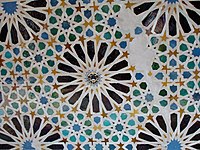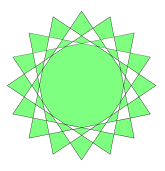A hexagon or hexadecagon is a polygon with 16 sides and 16 corners. The hexagons, like all polygons with at least four sides, can be divided into overturned and non-overturned (simple) hexagons. The simple ones turn into concave and convex hexagons. The latter can be differentiated according to other criteria such as side lengths, symmetries or the position of the corners.
In the following, this article deals with the regular hexagon - which is convex , has sixteen sides of equal length and the corners of which lie on a common perimeter - as well as regular overlapping hexagons.
Regular hexagon
Already the Greek mathematicians of antiquity was known that a regular hexadecagon with ruler and compass constructible is. This is possible because it can also be generated from a square or octagon by (continued) doubling the number of corners.
Sizes
| Sizes of a regular hexagon
|
|
Interior angle
|

|

|
Center angle
(Central angle)
|

|
|
Side length
|

|
|
Perimeter radius
|

|
|
Inscribed radius
|

|
|
height
|

|
|
Area
|

|
Mathematical relationships
Interior angle
The general formula for polygons gives

Center angle
The central angle or central angle is enclosed by two neighboring circumferential radii . In the general formula, insert the number for the variable :





Side length
To calculate the length of the side, think of the hexagon divided into 16 congruent triangles (determination triangles). If one half of such a triangle, that is a right triangle with sides , and as well with half the central angle so true






multiplying by gives


Algebraic expression:

Perimeter radius
The perimeter radius for a given side length is



Algebraic expression:

Inscribed radius
The incircle radius can also be determined using a halved determination triangle. It turns out


multiplying by gives


and further

because of

also applies

Algebraic expression:

height
The height of a regular hexagon is twice the incircle radius.


Area
The area of a triangle is calculated from In a determination triangle , the height is equal to the inscribed radius . The area of the entire hexagon, i.e. H. 16 determination triangles, is therefore




With the expression for derived in the incircle radius it follows


Algebraic expression:

Since the number of sides of a hexagon is a power of two , the area can also be calculated over the circumference with the radius using a formula derived from Vieta's product representation of the circle number Pi :


Geometric constructions
With a given radius
At first glance, it seems obvious to first draw one side of the octagon with its circumference and then to halve the central angle in order to get the side length of the sixteenth. However, it is also possible to determine the central angle in fewer construction steps.


Image 1: Hexagon for a given circumference
- ES begins (Fig. 1) with the drawing in of the diameter , followed by a point and an arc with a radius that intersect in and . The connecting line bisecting the diameter in After drawing of the circumscribed circle is the resulting intersection with connected. If one draws a circle arc around the radius of the connecting line in cuts. Finally, a half line follows from the center point through until it intersects the circumference at the corner point . Thus the first side of the resulting sixteenth has been found. After the remaining fifteen sides have been drawn in, the hexagon is complete.



















- The central angle with the angular width results from the interior angles of the isosceles triangle





- it follows

- An alternative construction (Fig. 2) halves the circumferential radius and an angle.


Image 2: Alternative construction of a regular hexagon with a given circumference, animation
For a given side length
The construction of a regular hexagon with a given side length (Fig. 3) is very similar to that of an octagon with a given side length .)
First, the end points of the side length are designated with and. This is followed by an arc with the radius around the point and a second with the same radius around ; the intersections and result . It continues with the ray from through and the parallels to from the point that the arc around in cuts. Now the point is connected with; the point of intersection is created . Then a bisector bisects the angle ; it cuts the half line in . In this way, the center of the resulting hexagon is determined. The center angle is provided by the second half-line through. After drawing in the circumference around and through , the corners and the hexagon result. Now, remove the missing side lengths on the circumference and finally connect the neighboring corners to a finished hexagon.





























The central angle with the angular width results from the interior angles of the isosceles triangle




it follows

Regular crossed hexagons
A regular over-arched sixteenth corner results if at least one is skipped over each time when connecting the sixteen corner points and the chords thus created are of the same length. Such regular stars are noted with Schläfli symbols , indicating the number of corner points and connecting every -th point.



There are only three regular sixteen-rayed stars, also called hexadecagrams.
The "stars" with the Schläfli symbols {16/2} and {16/14} are regular octagons and those with the Schläfli symbols {16/4} and {16/12} are squares . The stars with the Schläfli symbols {16/6} and {16/10} are eight stars, also called octograms.
- Regular sixteen ray stars



Occurrence
art

A sixteen-sided tile pattern of the
Alhambra ,
in the center the star {16/7}, {16/9}
In the Girih tile pattern in the Alhambra , there are also sixteen-sided symmetries.
In the early sixteenth century, Raphael was the first painter to depict a perspective representation of a regular sixteen-sided building in the painting The Marriage of the Virgin .
architecture
Hexagonal structures are z. E.g. the English A La Ronde from the 18th century, the Dutch lighthouse Huisduinen from the late 19th century and the former Panorama building in Leipzig . Sacred central buildings , such as the Aachen Cathedral in particular , have such a structure with the geometric conception of its Carolingian octagon together with the surrounding area and the sixteen-sided chapel inside the Magdeburg Cathedral .
Web links
Individual evidence
-
↑ Published in Nexus III: Architecture and Mathematics , Kim Williams (Ed.): Ospedaletto , Pisa: Pacini Editore, 2000, pp. 147–156.
-
↑ ottostadt magdeburg: The sixteen- cornered chapel. Otto the Great in Magdeburg Cathedral. Tourist Information Magdeburg, September 12, 2019, accessed on September 23, 2019 .





















































































